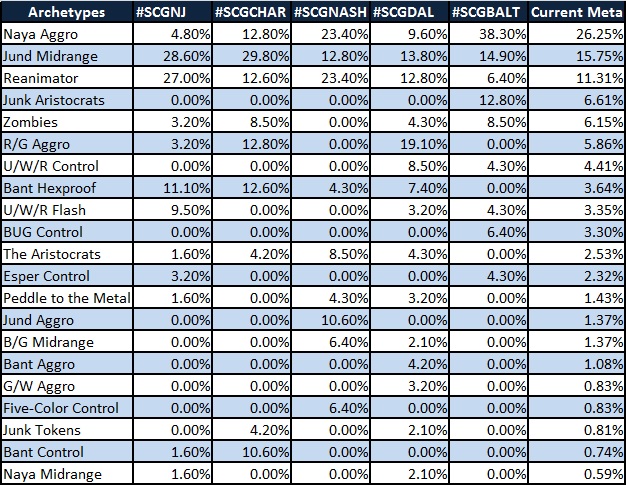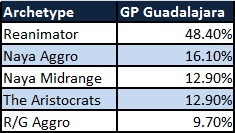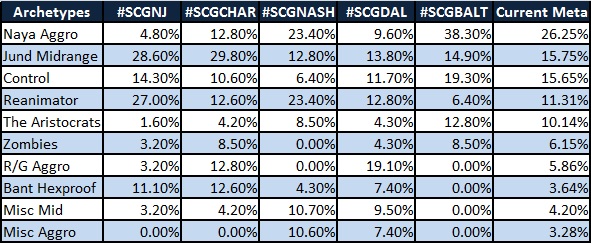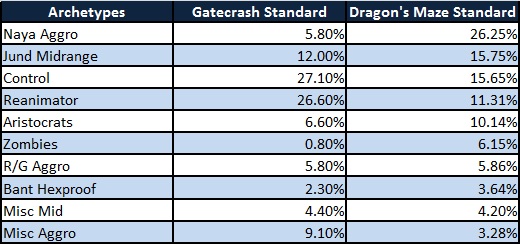This weekend marks the end of the first half of Dragon’s Maze Standard. A Block Pro Tour, non-Standard GPs, and now Modern Masters fast approaching is making this period of Standard seem to fly by. It’s hard to believe we are six weeks into the format, but this does make for a great opportunity to take a look at the first half of the metagame’s evolution and see where things are at for this weekend.
To start with, I compiled the metagame data from the first six SCG Opens of the season (SCG Dallas featured a Standard Open on both Saturday and Sunday) weighted by finish, similar to the winner’s circle metagame approach devised by Hall of Famer Frank Karsten. The following chart is an exhaustive look week by week at every archetype followed by a current metagame weighted by how recent the events have been (as tournaments from a month ago aren’t as big a metagame predictor as last week’s events). The only other major Standard tournament during this time period was GP Guadalajara a little over a week ago, which is discussed below.

21 major archetypes? Standard is certainly not short on diversity, that’s for sure.
This weekend’s deck of the weekend was definitely Naya Aggro, an archetype that has been around and getting results but just dominated this past weekend. Of course, one could argue that Naya Aggro has been absolutely dominating for three weeks in a row; it’s just that a week ago we saw a surge of R/G Aggro built like Naya Aggro decks.
Jund Midrange and Junk Reanimator were the twin towers of the format at its inception, and while they have settled down a little, they are still two of the three biggest decks in the format. In fact, GP Guadalajara suggests that Reanimator should even be higher. We don’t have a ton of info on that tournament yet, but here is the weighted metagame for its Top 8:

As you can see, no real big surprises, though Reanimator did have an absolutely fantastic showing. We don’t yet have all of the Top 16 data, but I know that both an Esper Control deck and a W/R/B Midrange deck appeared, which is a little bit of a new twist.
In order to make the above SCG data a bit more useful, I have combined a number of structurally similar archetypes to form a more condensed look at the metagame.

Control = U/W/R, BUG, Esper, Bant, Four-Color, Flash
Aristocrats = W/B/R and Junk
Misc Mid = Peddle, B/G, Junk Tokens, Naya
Misc Aggro = Jund, Bant, G/W
Now that we’ve cut the chart in half, the first thing that jumps out at me is the presence of control. It has been frequently been repeated that control (generally Sphinx’s Revelation) is dead. Just how true is that? After all, 15.65% of the field is not exactly a trivial amount. Is it possible that control has gotten this reputation not from being any weaker but from changing colors week to week.
U/W/R, BUG, Esper, Bant, Four-Color, and Flash variants have all enjoyed success, suggesting that a vital component of current Standard control is being different from the control decks people played last week. Is it just too easy to adapt to last week’s control decks? The decks to beat have evolved, but nowhere near as much or as fast as the control decks.
Of course, to lump all the control decks together and call it 15.65% of the field is not totally fair. We aren’t lumping all the aggro decks together, right? What does that 15.65% look like up next to the metagame from last season? If we looked at Gatecrash Standard through the lens of all control decks counting as one archetype, what would that look like? Here is a side-by-side comparison of Gatecrash Standard at the format’s end along with current Dragon’s Maze Standard:

Wow! What a difference a set can make! It is not always the easiest for a third set to shake up the metagame this much, particularly when it is a small set. Despite this, we see some pretty tremendous differences between the two formats.
To start with, control has nearly lost half of its metagame position, falling from 27.1% of the field to 15.65%. It’s not that control was just dominating last season; it’s just that Esper, U/W/R, and Bant were all major archetypes and there were a few minor ones. Now, not a single control deck is even 5% of the field. Control may not be dead, but it has certainly been knocked down a couple of rungs.
Control decks have been changing from week to week, continually seeking new ways to attack the format, with Aetherling perhaps giving them the greatest hope of a comeback. Even just one or two Aetherlings in a deck can go a long way towards giving it an inevitable endgame, and making other late-game cards far less important. This decrease in the importance of other late-game cards combined with the format’s heavy hostility towards Sphinx’s Revelation and Supreme Verdict have led to non-U/W/x control decks finally popping up again. Here is an example of one such list:
Creatures (9)
Planeswalkers (9)
- 2 Garruk, Primal Hunter
- 2 Liliana of the Veil
- 1 Garruk Relentless
- 2 Tamiyo, the Moon Sage
- 2 Jace, Architect of Thought
Lands (24)
Spells (18)

As you can see, Jake’s approach is to rely on planeswalkers instead of card draw for the most part. Green (instead of white) primarily adds Thragtusk, Farseek, and Garruks (not to mention Progenitor Mimic and sideboarded Deathrite Shaman and Gaze of Granite). Farseek in particular does some interesting things here, not only accelerating us into our tap-out plan but giving us enough functional Swamps to use Mutilate as a bona fide sweeper.
I like Aetherling a lot and would put two in a lot of decks, but with this many planeswalkers, Thragtusks, and Nephalia Drownyards, one is probably the perfect number for this list. The other six-drop, Progenitor Mimic, might be a little cute, but if you can Mimic a Thragtusk, it is just going to straight-up win the game against a lot of opponents.
Dragon’s Maze actually improves our reactive options a fair bit. Far // Away isn’t just a great edict; it’s also a sort-of card advantage engine with Snapcaster Mage and Thragtusk. Additionally, Warped Physique does a pretty mean Terminate impression, and Gaze of Granite solves some tough problems (albeit at a steep cost). Finally, Jake uses Notion Thief to try to recoup some lost percentage against opposing control decks that actually get to use Sphinx’s Revelation.
While there is no real "popular" control deck, perhaps the most common color combination is U/W/R, either resembling the Restoration Angel Flash decks of last season or a new breed of more pure control such as the following:
Creatures (4)
Planeswalkers (1)
Lands (26)
Spells (29)

Junk Reanimator was the big winner of last season, making one of the big questions if Dragon’s Maze would bring any change. Reanimator is nowhere near falling off (just look at its showing at the GP), but it does seem to have calmed down a lot. This isn’t a function of some new hate card, but rather other strategies gaining a little more (with Reanimator only really gaining Sin Collector). Here is an example of current Junk Reanimator, which should definitely be a part of any playtest gauntlet:
Creatures (26)
- 2 Acidic Slime
- 4 Arbor Elf
- 3 Fiend Hunter
- 4 Avacyn's Pilgrim
- 4 Restoration Angel
- 4 Thragtusk
- 3 Angel of Serenity
- 2 Sin Collector
Lands (23)
Spells (11)

Jund Midrange seems to be the force of consistency at the heart of both formats. Cards come and cards go, but Jund seems to be pretty squarely set as one of the better decks that is oppressive. It’s a good solid deck, hard to hate out, and has been enjoying a little more success in recent weeks as a result of Reanimator’s numbers dropping (a tough matchup for Jund, to be sure). Its primary new cards are Sire of Insanity (a mix of it and Rakdos’s Return has proven better than Rakdos’s Return alone) and Putrefy (a somewhat minor but solid upgrade to some of Jund’s removal). Here is an example of current Jund Midrange, another deck that is a must in any current Standard Gauntlet:
Creatures (13)
Planeswalkers (3)
Lands (25)
Spells (19)

The biggest gainer from Dragon’s Maze has arguably been Naya Aggro. While R/G Aggro’s numbers have basically not changed, Naya has shot through the roof. What is the cause of this divergence? To start with, Burning-Tree Emissary is no longer the key to all aggro decks as it once was. There is a new sheriff in town. Their name?
Voice of Resurgence has revolutionized how aggro decks are being built. A two-drop even stronger than Burning-Tree Emissary has people moving away from slavish devotion to creatures that can be cast off of it. This has brought with it an increase in Strangleroot Geists and Thalia, Guardian of Thrabens.
Where did control go? Well, Burning-Tree Emissary decks were so predictable that it was much easier to sculpt a game plan around removal spell, removal spell, Supreme Verdict. The combination of Voice of Resurgence, Strangleroot Geist, and Experiment One have current aggro decks far more resilient than those from a couple months ago.
Even the Naya spell set helps make it a tough time to Supreme Verdict, with Boros Charm as the hard counter and Advent of the Wurm providing a high-end bruiser with flash letting it come down the same turn as Verdict. Here is an example of current Naya Aggro and what should be deck #1 in the gauntlet:
Creatures (28)
- 4 Strangleroot Geist
- 4 Dryad Militant
- 4 Loxodon Smiter
- 4 Experiment One
- 4 Ghor-Clan Rampager
- 4 Boros Reckoner
- 4 Voice of Resurgence
Lands (22)
Spells (10)
Sideboard

The other major gainer from Dragon’s Maze was the Zombie archetype. Zombies was generally considered the most successful archetype of Return to Ravnica Standard, but it completely fell off with the printing of Gatecrash. By the end of the season, less than 1% of the winner’s circle metagame piloted Zombies. Now, Zombies has been putting up solid finishes almost every week. What changed?
Well, Blood Scrivener is legal and has been seeing consistent play, albeit in small numbers. Still, that is such a minor piece of the puzzle. The bigger factor has got to be the makeup of the rest of the format. Less Reanimator is not just less tough matchups but less splash hate from people going after the graveyard. Less control is interesting, as control has frequently been a good matchup for Zombies. Why has the decline of control actually helped the undead? Now, they no longer have to worry so much about playing too much removal and spending the slots it takes to beat control. They can get by just being creature decks with a little removal. Here’s an example of current Zombies:
Creatures (27)
- 2 Bloodthrone Vampire
- 4 Diregraf Ghoul
- 4 Gravecrawler
- 4 Falkenrath Aristocrat
- 2 Hellrider
- 4 Geralf's Messenger
- 3 Blood Artist
- 3 Knight of Infamy
- 1 Blood Scrivener
Planeswalkers (2)
Lands (23)
Spells (8)

Finally, we come to another archetype that has benefited a fair bit from the decline of control (and more importantly sweepers): The Aristocrats. The Aristocrats spent most of last season as a minor role-player that popped up from time to time. Now that control is safely under control, The Aristocrats is making a case for tier 1.
In recent weeks, Act 2 had been enjoying a reasonable level of success, but this past weekend Brad Nelson may have completely turned the format on its head with a third act of sorts: Junk Aristocrats. The Aristocrats was already a candidate for a spot in playtest gauntlets, and after this weekend’s showing I would be sure to get some experience against this new build. Brad has been making a lot of breakthrough decks over the past year, and his #SCGBALT-winning list is no exception:
Creatures (24)
- 3 Skirsdag High Priest
- 4 Doomed Traveler
- 2 Young Wolf
- 4 Blood Artist
- 4 Cartel Aristocrat
- 3 Varolz, the Scar-Striped
- 4 Voice of Resurgence
Planeswalkers (3)
Lands (25)
Spells (8)

This new version replaces Falkenrath Aristocrat with Varolz, the Scar-Striped, taking the deck into an even more "anti-aggro aggro-deck" direction. On top of this, it gets to take advantage of Voice of Resurgence, the greatest Doomed Traveler of them all. It’s not just the raw power of Voice that is so great here. Voice is a fantastic creature to sacrifice, and the token it makes is often going to be huge thanks to all of the token-making power Nelson is using.
Sin Collector out of the sideboard is standard issue for all Aristocrats decks (and all W/B/x decks really), but Unflinching Courage is a new Dragon’s Maze card that we get as part of giving up red for green. Unflinching Courage is great against removal-light decks anyway, but here it can go on Cartel Aristocrats or Varolz to make a particularly difficult threat to remove. Other games we’re just going to throw it on a Demon and win an easy race in the air.
No question, Dragon’s Maze Standard is a rich and diverse format that continues to evolve week to week. I don’t think we’re even close to the end of the format’s life cycle, and it’s not clear that there won’t be multiple new major archetypes six weeks from now. If you ask me, Aetherling is the new part of the puzzle that needs to be understood and has the potential to help blue decks escape their slavish devotion to Supreme Verdict (and crippling weakness to Voice of Resurgence).
Which of these archetypes is going to drop in popularity over the next two weeks? What archetype is missing from these charts or that you expect to make an appearance in the next two weeks? See you next week!
Patrick Chapin
"The Innovator"
